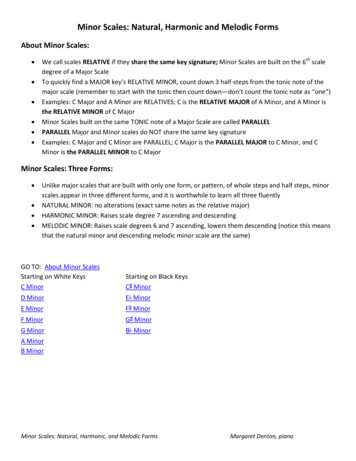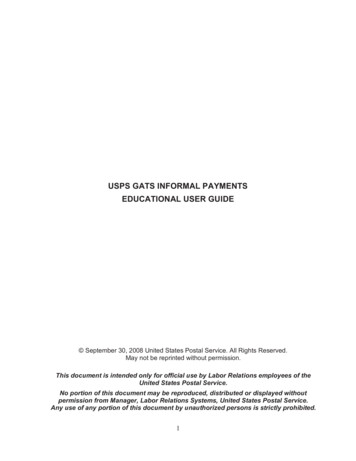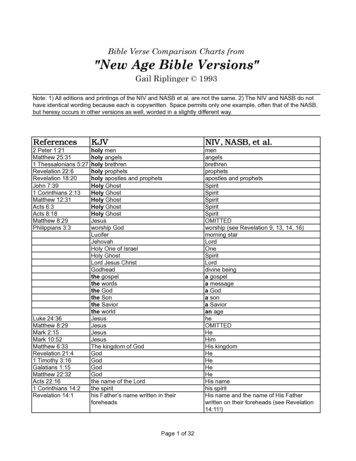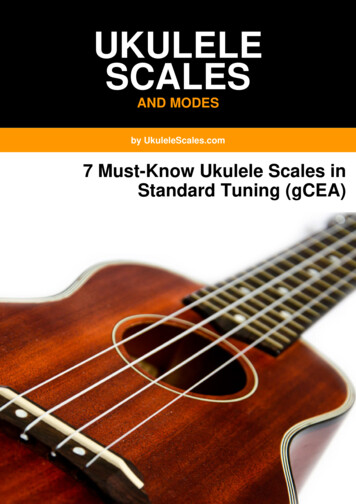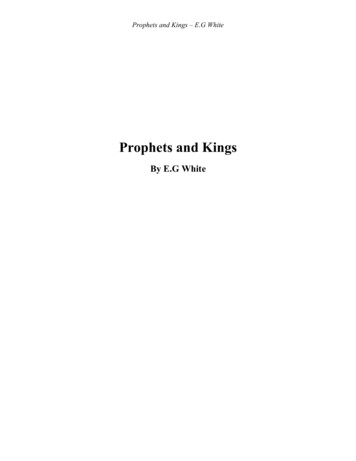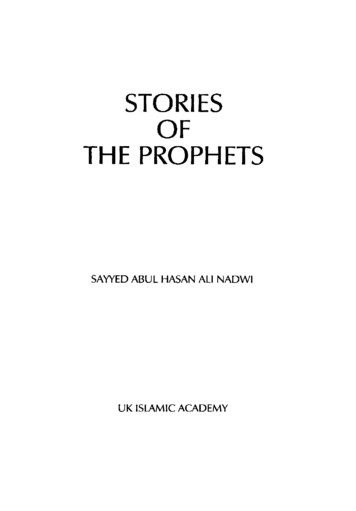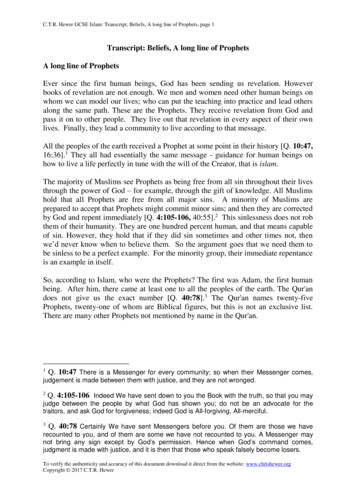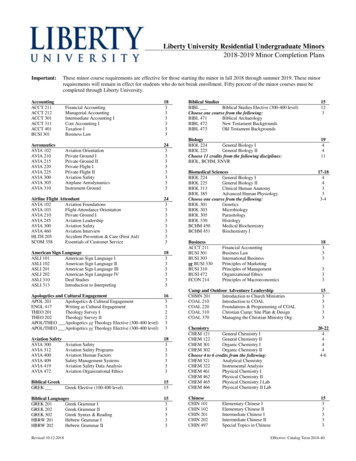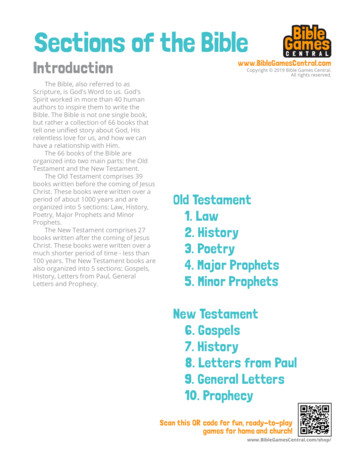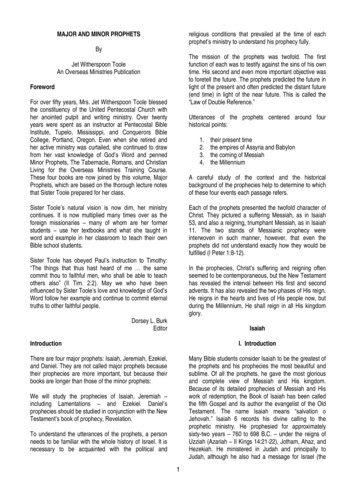
Transcription
MAJOR AND MINOR PROPHETSreligious conditions that prevailed at the time of eachprophet’s ministry to understand his prophecy fully.ByThe mission of the prophets was twofold. The firstfunction of each was to testify against the sins of his owntime. His second and even more important objective wasto foretell the future. The prophets predicted the future inlight of the present and often predicted the distant future(end time) in light of the near future. This is called the“Law of Double Reference.”Jet Witherspoon TooleAn Overseas Ministries PublicationForewordFor over fifty years, Mrs. Jet Witherspoon Toole blessedthe constituency of the United Pentecostal Church withher anointed pulpit and writing ministry. Over twentyyears were spent as an instructor at Pentecostal BibleInstitute, Tupelo, Mississippi, and Conquerors BibleCollege, Portland, Oregon. Even when she retired andher active ministry was curtailed, she continued to drawfrom her vast knowledge of God’s Word and pennedMinor Prophets, The Tabernacle, Romans, and ChristianLiving for the Overseas Ministries Training Course.These four books are now joined by this volume, MajorProphets, which are based on the thorough lecture notesthat Sister Toole prepared for her class.Utterances of the prophets centered around fourhistorical points:1.2.3.4.their present timethe empires of Assyria and Babylonthe coming of Messiahthe MillenniumA careful study of the context and the historicalbackground of the prophecies help to determine to whichof these four events each passage refers.Sister Toole’s natural vision is now dim, her ministrycontinues. It is now multiplied many times over as theforeign missionaries – many of whom are her formerstudents – use her textbooks and what she taught inword and example in her classroom to teach their ownBible school students.Each of the prophets presented the twofold character ofChrist. They pictured a suffering Messiah, as in Isaiah53, and also a reigning, triumphant Messiah, as in Isaiah11. The two stands of Messianic prophecy wereinterwoven in such manner, however, that even theprophets did not understand exactly how they would befulfilled (I Peter 1:8-12).Sister Toole has obeyed Paul’s instruction to Timothy:“The things that thus hast heard of me the samecommit thou to faithful men, who shall be able to teachothers also” (II Tim. 2:2). May we who have beeninfluenced by Sister Toole’s love and knowledge of God’sWord follow her example and continue to commit eternaltruths to other faithful people.In the prophecies, Christ’s suffering and reigning oftenseemed to be contemporaneous, but the New Testamenthas revealed the interval between His first and secondadvents. It has also revealed the two phases of His reign.He reigns in the hearts and lives of His people now, butduring the Millennium, He shall reign in all His kingdomglory.Dorsey L. BurkEditorIsaiahIntroductionI. IntroductionThere are four major prophets: Isaiah, Jeremiah, Ezekiel,and Daniel. They are not called major prophets becausetheir prophecies are more important, but because theirbooks are longer than those of the minor prophets:Many Bible students consider Isaiah to be the greatest ofthe prophets and his prophecies the most beautiful andsublime. Of all the prophets, he gave the most gloriousand complete view of Messiah and His kingdom.Because of its detailed prophecies of Messiah and Hiswork of redemption, the Book of Isaiah has been calledthe fifth Gospel and its author the evangelist of the OldTestament. The name Isaiah means “salvation oJehovah.” Isaiah 6 records his divine calling to theprophetic ministry. He prophesied for approximatelysixty-two years – 760 to 698 B.C. – under the reigns ofUzziah (Azariah – II Kings 14:21-22), Jotham, Ahaz, andHezekiah. He ministered in Judah and principally toJudah, although he also had a message for Israel (theWe will study the prophecies of Isaiah, Jeremiah –including Lamentations – and Ezekiel. Daniel’sprophecies should be studied in conjunction with the NewTestament’s book of prophecy, Revelation.To understand the utterances of the prophets, a personneeds to be familiar with the whole history of Israel. It isnecessary to be acquainted with the political and1
ten northern tribes). The northern kingdom of Israel wastaken captive by Assyria under the reign of Hoshea,about 721 B.C., during the reign of Ahaz over Judah.Tradition states that the wicked king Manasseh causedIsaiah’s death by putting him into a hollow log, which wasthen sawed asunder. See Hebrews 11:37.Isaiah 3 looks ahead of the fall of Judah and Jerusalemfor their sins (verses 1-9). It promises righteous judgmentand justice to the wicked as well as the righteous (verses10-15). Verses 16-26 picture the sinful pride of thewomen and predict their judgment.The historical background for Isaiah’s prophecy is foundin II Chron. 26-32. (The student should note thedistinction between the historical backgrounds of Isaiah’sprophecy ad the historical section of the Book of Isaiah.)Isaiah 4 is a vision of the future glory of the kingdom ofGod. His people will be redeemed from their wickedness.Isaiah 5 gives a parable of the Lord’s vineyard thatshows the unfaithfulness of both Israel and Judah(verses 1-7). (Compare with John 15:1-7.) Verses 8-30announce six woes of God’s judgment on the people fortheir sins.II. Overview of BookA. Condemnatory Section (Isaiah 1-35)This section is concerned primarily with rebukes forJudah’s sins.Isaiah 1-12 Prophecies concerning Judah andJerusalemIsaiah 13:23 Prophecies of judgment on thenationsIsaiah 24-27 Prophecies of world judgment,ending in Israel’s redemptionIsaiah 28-35 Prophecies of judgment and mercyIsaiah 6 describes Isaiah’s vision and call to theprophetic ministry and predicts the people’s rejection ofhis message and their judgment (verses 1-13).Isaiah 7 records the evil confederacy of the king of Isaiah(ten tribes) with the king of Syria. God sent Isaiah with amessage to Ahaz, king of Judah. The main prophecy ofthis chapter is verse 14, which announces that Messiahwould be born of a virgin and His name would be calledImmanuel. (See Matthew 1:21-23)B. Historical Section (Isaiah 36-39)Isaiah 8 predicts the Assyria invasion of Judah and giveswarning to the people of Israel and Judah.This section contains a part of Judah’s history under thereign of Hezekiah. Isaiah 39:5-8 is a prophecy of theBabylonian captivity.Isaiah 36-39 Invasion of Judah by Assyria andJudah’s deliveranceIsaiah 9 is a beautiful prophecy of Messiah and Hisaccomplishment. Note especially verses 6 and 7.Isaiah 10 predicts God’s judgment on Assyria andSamaria, while promising that Judah would also bepunished for her sins of idolatry. But He promisedsalvation for the righteous remnant.C. Consolatory Section (Isaiah 40-66)This section contains words of comfort to chastised Israeland promises restoration and blessings.Isaiah 40-48 Deliverance from captivity throughthe agency of CyrusIsaiah 49-57 Redemption through the sufferingand sacrifice of ChristIsaiah 58-66 The future glory of God’sredeemed peopleIsaiah 11 portrays briefly the peace and righteousness ofthe millennial reign.Isaiah 12 is the beautiful prophecy that Jehovah wouldbecome our salvation in Messiah and mentions that Hisname would be exalted. (See Philippians 2:9-10)III. A Brief Resume of the ChaptersIsaiah 12-27 consists mostly of judgments pronouncedagainst the various nations. By God’s judgment theinhabitants would learn righteousness (26:9). In His finaljudgment on the nations, God promised to hide Hispeople away in a place of safety 26:20-21), which isapparently the marriage supper of the Lamb (Rev. 19:79; I Cor. 15:51-57; I Thess. 4:13-18). Israel’s own effortsto save itself were compared to a bed too short for a manto stretch himself on and a covering to narrow to wraphimself in (28:20). The only covering that hide Israel’ssins was the covering of God’s Spirit that would beprovided in Christ (30:1). The people of Israel wereIsaiah 1 portrays the sinful condition of Judah at the timeof Isaiah’s prophecy. If it had not been for a smallremnant of the faithful, the nation would have been totallydestroyed, even as Sodom and Gomorrah were (verse9). But in spite of their sinful condition, God promisedredemption for His people.Isaiah 2 promises salvation for the faithful in the end time(verses 1-5), but God promised to humble and punish theproud and idolatrous (verses 6-22).2
bringing God’s judgment upon themselves by going toEgypt and turning to the arm of flesh for help (31:1-3).The only hiding place from the tempests of judgment andstorms of life was the promised King who would come treign in righteousness.Isaiah 34:1-8 pictures God’s wrath upon the nations inthe Battle of Armageddon. (See Rev. 19:11-12)Isaiah 66:20-42 closes Isaiah’s prophesies with thepromise of new heavens and a new earth in theconsummation of God’s salvation of His people. (See IIPeter 3:10-14.)Study Questions on Isaiah1. What was Israel’s sinful condition as picture Isaiah 1?What spiritual restoration was predicted?2. What was said of Israel’s idolatry in Isaiah 2? Whatjudgment did God pronounce on Israel for heridolatry?3. What picture of the women’s vanity was given inIsaiah 3?4. What picture of restoration was given in Isaiah 4?5. What interpretation was given of the parable of thevineyard in Isaiah 5? What comparison may bedrawn between this parable and Jesus’ teaching inJohn 15:1-7?6. For what six sins was woe pronounced on Isaiah inIsaiah 5?7. Describe Isaiah’s vision and call to the propheticministry as given in Isaiah 68. What important prophecy of Christ was given inIsaiah 7? What was its New Testament fulfillment?Give the Scripture reference.9. What invasion was predicted in Isaiah 8? What wasthe Lord’s provision for Israel’s deliverance?10. What important prophecy about Christ was given inIsaiah 9? How was Christ identified in this prophecy?11. What punishment for Israel’s sin did the Lordpromise in Isaiah 11?12. What was prophesied of Assyria in Isaiah 10? Whathope was held out to Israel?13. What picture of the Lord’s future kingdom is given inIsaiah 11?14. What was the fulfillment of the prophecy of Isaiah12?15. What was prophesied of Babylon in Isaiah 13? Towhat does this Babylon refer (verse 11)? To whatdoes the “day of the LORD’ refer (verse 9)?16. What consolation is held out to Israel in Isaiah 14?17. What is shown to be the origin of Babylon’s prideand evil in Isaiah 14?18. To what does the destruction of Babylon refer inIsaiah 14?19. What is prophesied of Moab in Isaiah 15-16? Whowere the Moabites?20. What was prophesied of Damascus in Isaiah 17?What nation did Damascus represent?21. On what nation was woe pronounced in Isaiah 18?22. On what nation was woe pronounced in Isaiah 19?23. What was indicated by Isaiah’s pronouncement ofjudgment on the many different nations? (SeeDaniel 2:31-45.)24. What nation did the Lord ordain to destroy Egypt andEthiopia in Isaiah 20?Isaiah 35:8 describe the way (road) to heaven that Godwould provide in Christ as a highway of holiness (seeJohn 14:1-6).Isaiah 36-39 (the historical section) tells of the Assyrian’sinvasion of Judah, God’s deliverance in answer toHezekiah’s prayers, Hezekiah’s sickness and recovery,and the king’s folly of pride in showing his treasures toforeign visitors.Isaiah 40 promises the forerunner of Christ (John theBaptist – compare verses 3-8 with Luke 3:4-6). Then itportrays the greatness of the Lord who would come(verses 9-28) and the greatness of the salvation hewould bring to humanity (verses 29-31).Isaiah 41-48 emphasizes that there is just one God andthat he is the Savior of His people (42:8; 43:10-17; 44:6;45:5; 46:9-10; 48:5, 12-13). Isaiah 41:2, 44:24-28, and45:1 speak of the Persian king Cyrus by whom Godwould deliver His people from Babylonian captivity. (SeeEzra 1:1, 11.) The remarkable thing about this prophecyis that the prophet called his name about 150 yearsbefore his birth.Isaiah 49-57 is primarily concerned with the coming ofMessiah and the salvation He would provide throughsuffering. His name would be announced before Hisbirth. (Compare 49:1 with Matt. 1:21.) His word would beas a sharp sword. (Compare 49:2 and 50:4 with He. 4:12and John 7:46.) Isaiah 50:6-9, 52:14, and 53:1-12describe His suffering. Isaiah 51:9-11, 52:1-12, 55:1-3,and 57:15-19 describe the joy and blessings of thesalvation He would provide for men through His suffering.Isaiah 58 shows that religious ceremony is not sufficientto save and that God only hears the prayers of those whoturn away from sin.Isaiah 59 shows that the sins of men had separated themfrom God (verses 1-9) and that no one but the Lord couldsave them from their sins (verses 16-21).Isaiah 61:1-2 is the text that Jesus read in the synagoguein Nazareth.Isaiah 56:6-7, 63:16, and 65:1 foretell that God wouldreceive the Gentiles.3
25. In Isaiah 21, what nation did the Lord ordain itdestroy Babylon?26. What is the interpretation of the prophecy of Isaiah22? (See II Chron. 32:1-5, 30.)27. Against what country was judgment predicted inIsaiah 23?28. To what does the prophecy of Isaiah 24 refer?(See Rev. 19:11-17.)29. Give Scripture references that help to interpret theprophecy of Isaiah 25.30. What was God’s purpose in judgment, as revealed inIsaiah 26? Of what were verses 20&21 prophetic?31. What restoration of Israel was predicted in Isaiah27?32. What captivity and restoration was pictured in Isaiah28? What is the interpretation of verse 20?33. Give New Testament interpretations of the prophecyof Isaiah 29.34. What were the people of Israel warned against inIsaiah 30-31? What deliverance was promised tothem?35. What restoration was promised in Isaiah 32?36. What was pictured in Isaiah 33?37. What was pictured in Isaiah 34?38. What was pictured in Isaiah 35?39. What of Judah’s history was recorded in thehistorical section of Isaiah 36-39? What was God’sanswer, through Isaiah, to the Assyrian threat? Howdid God fulfill His promise (Isaiah 37)?40. What was Hezekiah’s folly as recorded in Isaiah 39?41. Of whom did Isaiah prophecy in Isaiah 40:1-5?42. How did Isaiah picture the Lord in Isaiah 40:9-31?43. What was shown of the weakness of men in Isaiah41? What was shown to be the hope of weak men?44. What New Testament passage interprets theprophecy of Isaiah 42:1-12?45. What two aspects of Israel’s restoration are shown inIsaiah 43? To what does verse 27 refer?46. What is emphasized in Isaiah 44-46?47. What was prophesied about Cyrus in Isaiah 44:2428 and 45:1-4? When and how was this prophecyfulfilled?48. In Isaiah 47 to what does the judgment of Babylonrefer? (See Rev. 17:1-18.)49. In Isaiah 49, what judgment was pronounced onIsrael and what promise was given?50. What New Testament passage interprets theprophecy about Christ in Isaiah 49?51. What was the fulfillment of the prophecy about Christin Isaiah 50?52. In Isaiah 51, what does the prophecy about Israelrefer?53. Give New Testament interpretations of theprophesies of Isaiah 52.54. How was the prophecy of Isaiah 53 minutelyfulfilled?55. What restoration of Israel was prophesied in Isaiah54? (See Rev. 7:1-8.)56. What picture of salvation in Christ was given inIsaiah 55?57. Name some of the admonitions given in Isaiah 56.58. What rebukes and what promises were given inIsaiah 57?59. How was Israel’s hypocrisy pictured in Isaiah 58?60. What picture of the lost was given in Isaiah 59?What was shown to be man’s only hope?61. In Isaiah 60, how was the salvation of Christ shownto be universal?62. What was the New Testament fulfillment of Isaiah61?63. What was prophesied of Israel in Isaiah 62?64. In Isaiah 63, to what do verses 1-6 refer? To whatdo verses 7-19 refer? To what does verse 16 refers?65. In Isaiah 64, what did Isaiah predict of the futureattitude of the people of Israel toward their need?What situation was to bring them to this attitude?66. In Isaiah 66, what was shown to be God’srequirement for salvation? What was shown to beHis provision of salvation?JeremiahI. IntroductionJeremiah was the son of a priest from Anathoth.(Anathoth was located about three miles northeast ofJerusalem.) He began prophesying during the thirteenthyear of Josiah’s reign and continued until the captivity ofJudah and the destruction of Jerusalem by theBabylonians about forty years later (Jeremiah 1:2-3). Heis called the weeping prophet because of the greatburden he carried for his own people.II. Historical BackgroundWe shall briefly study the years of Jeremiah’s prophecyunder the reign of each of the kings of Judah from Josiahto Zedekiah. This historical information is found in IIKings 22-25 and II Chron. 34-36.A. Josiah (II Kings 22:1; II Chron. 34:1)Josiah reigned eighteen years. He was a good andfaithful king. At the age of sixteen he began to seek thelord, and when he was twenty years old, in the twelfthyear of his reign, he began to purge Judah andJerusalem of idolatry (II Chron. 34:1-7). He then orderedthe renovation and repair of the Temple, in the process ofwhich the book of the law of Moses was found (II Kings22:3-10; II Chron. 34:8-10). Evidently the law had notbeen read to the people of Judah for many years, andJosiah rent his clothes out of great concern when hebecame conscious, through the hearing of the law, of thesinfulness of the people. He sent priests to inquire of the4
Lord. The Lord answered through the prophetess Huldahthat He would judge the people for their sins, but due toJosiah’s faithfulness, the judgment would not fall duringhis lifetime (II Kings 22:11-20; II Chron. 34:18-28).Chron. 36:9-10). Evidently Ezekiel was also taken toBabylon with this group, approximately five years afterDaniel had been taken to Babylon.E. Zedekiah (II Kings 24:17-19; II Chron. 36:10-12; Jer.37:1-2)Josiah then read the law to all the people and zealouslytried to stamp out idolatry in Judah. He held the greatestPassover feast that the people had known in many years(II Kings 23:1-25; II Chron. 34:29-33; 35:1-19).Nebuchadnezzar made Mattaniah king of Judah in placeof Jehoiachin and changed his name to Zedekiah (IIKings 24:17-19; II Chron. 36:10). He was a son of Josiahand brother to Jehoiakim (Jer. 37:1). Zedekiah reignedeleven years, till the fall of Jerusalem. He came toJeremiah secretly on various occasions to inquire of thewill of the lord. He was too weak, however, to take astand against the princes of his court. He finally yieldedto their pressure to rebel against Nebuchadnezzar inspite of Jeremiah’s warning against such action (Jer.37:11-21; 38:2-28). When Zedekiah rebelled in the ninthyear of his reign, Nebuchadnezzar sent his armies tobesiege Jerusalem. In less than two years, in theeleventh year of Zedekiah’s reign, Jerusalem was takenand destroyed (II Kings 25:1-21; II Chron. 36:11-21; Jer.39:1-12; 40:2-6).Nevertheless, he seems to have made one mistake. TheEgyptians pharaoh marched through the land on his wayto wage war against Assyria. Josiah, evidently againstthe will of God, encountered him in battle in Megiddo.Josiah was killed in this battle, and his son Jehoahazwas crowned king of Judah (II Kings 23:31-33; II Chron.35:20-27; 36:1-2).B. Jehoahaz, son of Josiah (II Kings 23:31-33; II Chron.36:1-3).Jehoahaz had reigned only three months when Judahwas subjugated by the pharaoh of Egypt. He was carriedto Egypt where he died.III. A Brief Resume of the ChaptersC. Jehoiakim, son of Josiah and the same as Eliakim (IIKings 23:34-36; II Chron. 36:4-8)Jeremiah 1:4-10 records Jeremiah’s call to the propheticministry. It appears he was called when quite young,since he called himself a child (verse 6).Pharaoh-nechoh bound Judah under tribute and madeJehoahaz’s brother, Eliakim, of Judah, changing hisname to Jehoiakim (II Kings 23:32-32; II Chron. 36:1-5).Jehoiakim became a very wicked king and persecutedJeremiah.Jeremiah 2:1-3:5 is Jeremiah’s first message to theJews. He rebuked the unfaithfulness of the priests andkings, the false prophets, and the idolatry of the people.He charged them with two evils: forsaking the Lord andsubstituting idols in His place (2:13). He said the noblevine God had planted had degenerated into a strange orwild vine (2:1). (See Isaiah 5:2.)After three or four years, Nebuchadnezzar gained powerover most of the territory held by Assyria and Egypt. Hesubjugated Judah and brought Jehoiakim under hisjurisdiction. Three years later, Jehoiakim rebelled againstthe rule of Nebuchadnezzar. He was arrested, and planswere made to carry him to Babylon. However, it appearsthat he was not taken to Babylon but reigned inJerusalem about another five years, the overall period ofhis reign being eleven years (II Kings 24:1-7; II Chron.36:5-8; Jer. 25:1-3; Dan. 1:1-2). The vessels andtreasures that Nebuchadnezzar carried to Babylon at thistime were probably given to him as tax by Jehoiakim.And some of the best of the young men of Judah,including Daniel and his friends, were taken to Babylon atthis time (Dan. 1:1-7).Jeremiah 3:6-6:30 is Jeremiah’s second message. Herebuked Judah for disregarding the warning of thecaptivity of her sister Israel (the ten tribes). Judah hadblindly followed in the footsteps of Israel in her idolatry(3:6-11).D. Jehoiakim (II Kings 24:6-10; II Chron. 36:8-10)Jeremiah called the people to repent (3:12-25; 4:1-4).Yet, since he knew there would be no permanentrepentance, he pronounced their doom (4:7-13). Theypretended to worship the Lord Jehovah while continuingin their wicked ways (5:1-15). He called them toremember and return to their former state of faith andblessing, but they refused to heed his pleading (6:16-17).When Jehoiakim died, his son Jehoiachin became king ofJudah. He had reigned only three months whenNebuchadnezzar’s armies again besieged Jerusalem.Jehoiachin gave himself up to them, and his family, andhis officials were taken to Babylon (II Kings 24:8-16; IIJeremiah 7-10 gives Jeremiah’s message in the gate ofthe Lord’s house. He rebuked the people for believing thelying prophets who promised a false security (7:4-10). Hewarned that God would permit them to be destroyedeven as He had permitted the Philistines to carry the ark5
away from the Tabernacle in Shiloh (7:12-14). He saidwhen their enemies destroyed Jerusalem they woulddishonor Judah by taking the bones of their kings andprinces from the tombs and scattering them in the open(8:1-3).Jeremiah 18:1-19:13 records Jeremiah’s learning in thepotter’s house how God would take the marred people ofJudah and either save or destroy them according to theirattitude. He could do with them as He willed, even as thepotter with he clay.Jeremiah expressed his own grief over Judah’s sinfulcondition (8:18-22; 9:1-2). He pronounced God’sjudgment on Judah as well as on all the other nations(9:23-26). He rebuked the people for trusting in lifelessidols that could do neither good nor evil while theyforsook the living God who created all things (10:1-13).He acknowledged that due to carnality they could notmake themselves righteousness (10:23-24).Jeremiah 19:14-20:18 portrays Jeremiah’s reaction to hisfirst persecution. He first thought he would cease givingout the message of judgment that had brought on hispersecution, but the Word of God became like a fire shutup in his bones. He could not be silent (20:7-9).Jeremiah 21-22 relates Jeremiah’s answer to Zedekiah’sinquiry concerning Nebuchadnezzar’s invasion. Heanswered that if Judah repented of her sins she could bespared, but if she did not the kingdom would surely begiven to the Babylonians.Jeremiah 11-12 contains Jeremiah’s message of thebroken covenant. This was prompted by the finding of thebook of the law in the renovation of the Temple byJosiah. The law revealed that Judah was under greatcondemnation for having broken the law of God (1:1-13).The people would be punished for persecuting God’sprophet (11:18-23). They were to be carried into captivity,but when they repented God would bring them backagain (12:15). However, during their captivity they shouldspread the doctrine of one true God among the heathen(12:16).Jeremiah 23:4-6 promises the coming of Israel’srighteous King and Messiah, through whom they wouldbe redeemed and made righteous. The remainder of thechapter warns against relying on false security promisedby lying prophets.Jeremiah 24 describes good and bad figs. By thesesigns, God showed that the repentant Jews would berestored but the wicked ones would be destroyed.Jeremiah 13 is Jeremiah’s message that he illustrated bythe sign of the linen girdle. As his girdle was spoiled bybeing buried in the hole of a rock by the Euphrates River,so Judah would be buried among the heathens of thecountry of the Euphrates because they had failed to clingto the Lord as a girdle should bind the garment (13:1-11).But Judah could no more make herself righteous than anEthiopian could change his skin or a leopard his spots(13:23).Jeremiah 25:10-11 predicts Israel’s repentance inBabylon and their restoration after seventy years ofcaptivity (Psalms 126 and 137).Jeremiah 26 relates the priests’ decision to kill Jeremiah.Nevertheless, he was saved by the pleading of theprinces and the people, who used the example ofMicah’s prophecy in the days of Hezekiah (26:11-19).Jeremiah 14-15 warns Judah of a coming drought andother judgments. (See Deu. 28:15; 23:24.) Jeremiah hadto battle against the influence of false prophets whodenied that these things would come to past (14:13-16).When he interceded for the people, the Lord told himthey had gone so far in sin that even if Moses andSamuel were there to intercede, He would not sparethem (15:1, 6). However, He promised to save the smallrighteous remnant (15:11-21).Jeremiah 27-28 recounts how Jeremiah predictedJudah’s subjugation by Babylon using the sign of a yoke,but it promises deliverance in the day (or reign) ofNebuchadnezzar’s grandson (27:7).Jeremiah 29 tells of Jeremiah’s letter of warning andcomfort to the captive already in Babylon.Jeremiah 30 records God’s command to Jeremiah towrite all the words of God in a book. When the peoplereturned from captivity, this book would confirm the truthand fulfillment of all the Word of God.Jeremiah 16:1-17:18 gives Jeremiah’s message in whichhe used his own unmarried state to emphasize thenearness of Judah’s destruction (16:1-9). Again hewarned the people against trusting in the arm of flesh,but he promised that God would try their hearts and blessall who trusted in Him (17:5, 7, 9-10).Jeremiah 31 gives the Lord’s promise that the captiveswould return from Babylon and rebuild and worship intheir land. The long-range view promised spiritualrestoration through the new covenant of Messiah (31:3134; Hebrews 8:6-12).Jeremiah 17:19-27 warns against breaking the Sabbath,which was a sign of God’s covenant with Israel and atype of their eternal rest.6
Jeremiah 32 demonstrates Jeremiah’s faith in God’spromise of restoration by his redeeming the inheritanceof his uncle’s son (verses 6-18).They boldly defied him and deliberately went after idolsuntil they were destroyed according to Jeremiah’sprophecy.Jeremiah 33 records the Lord’s promise that He wouldcause His people to return from captivity. He againpromised final deliverance through the Branch of thehouse of David verses 15-18). This promise was as sureas His covenant of day and night (verses 19-26).Jeremiah 45 is a message of comfort to Baruch in thedays of Jehoiakim.Jeremiah 34 describes how that, in the face of aBabylonian siege and an earlier deportation, Zedekiahmade a covenant to release Hebrew slaves. But whenBabylon lifted the siege for a time, he retracted hiscovenant and God again pronounced destruction onJudah.Jeremiah 46-51 is Jeremiah’s messages of judgmentagainst the Gentile nations. These messages look aheadto the destruction of all worldly powers by the Lord atArmageddon (Dan. 2:40-45). As both Isaiah andJeremiah prophesied, Babylon was destroyed by theMedes and Persians (Dan. 5:1-31). And by the law ofdouble reference, this prophecy foreshadows the endtime destruction of the kingdom of Antichrist, which isalso called Babylon (Rev. 17-19).Jeremiah 35 contrasts the disobedience of Judah withthe obedience of the Rechabites (Kenites) to thecommand of their elders. (See I Cor. 2:55.)Jeremiah 52 records the destruction of Jerusalem andthe kindness shown to Jehoiachin in his latter days byEvil-merodach, the son of Nebuchadnezzar.Jeremiah 36 recounts that when Jeremiah was shut up inprison during the reign of Jehoiakim, he called for Baruchto write his prophetic words and read them in the houseof the Lord. Jehoiakim burned the roll (book) of God’sWord, but Jeremiah dictated all the words to Baruchagain and added a judgment against Jehoiakim.Study Questions on Jeremiah1. Describe Jeremiah’s call to the prophetic ministry.2. What was Jeremiah’s first message to the Jews?With what two evils did he charge them? What did hesay about the noble vine of God?3. What was Jeremiah’s second message of the Jews?Why did he rebuke Judah? What promise did hegive?4. What was Jeremiah’s message in the gate of theLord’s house? For what two reasons did he rebukethe people? How did he express his own grief overJudah’s sinful condition? What judgment did hepronounce on Judah?5. What prompted the message of the brokencovenant? What punishment was pronounced on thenation? Why? What promise was given?6. What is the significance of the sign of the linengirdle?7. Why did Jeremiah have to battle the false prophets?What did the Lord tell him concerning the condition ofthe people? What promise did the Lord give (15:1121)?8. What was the significance of Jeremiah’s unmarriedstate as it related to Judah? What did he warn thepeople against?9. The Sabbath was a sign of what?10. What lesson did Jeremiah learn in the potter’shouse?11. What was Jeremiah’s reaction to his firstpersecution?12. What was Jeremiah’s answer to Zedekiah’s inquiryconcerning Nebuchadnezzar’s invasion?13. What promise was given concerning the coming ofIsrael’s righteous King a
years were spent as an instructor at Pentecostal Bible Institute, Tupelo, Mississippi, and Conquerors Bible College, Portland, Oregon. Even when she retired and her active ministry was curtailed, she continued to draw from her vast knowledge of God's Word and penned Minor Prophets, The Tabernacle, Romans, and Christian
